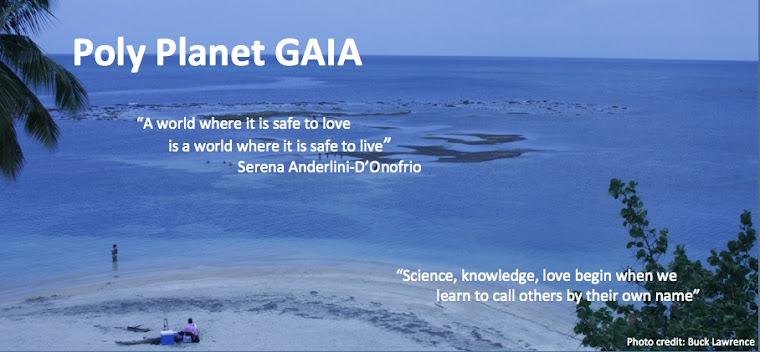"Bisexuality, Gaia, Eros: Portals to the Arts of Loving"
BiReCon: Selected Proceedings from the 2010 Int'l Bisexual Research Conference
Serena Anderlini-D'Onofrio, PhD, Keynote Speaker
Part 1 - Preamble: Manifesting Bisexuality, Cont'd
Attending BiReCon put me in touch with research projects funded by the American Institute of Bisexuality. AIB has been in action on this count. Its current emphasis on bi men is a way to put the accent where it’s needed. I tend to date bisexual men because their potential for love is expanded. They are more likely to enjoy their own erotic receptivity in the arts of loving and to be more adept in feeling the pleasure of the other. For me that’s the mark of an artist. I was overjoyed to see my hunch confirmed by research on bi men’s brain function. Apparently, when given a chance to feel comfortable with their amorous practices, bi men are every bit as healthy, happy, and sound as anybody else. The only difference is a plus: When it comes to bi men, we find erotophilia in abundance![1]
I also know of course how difficult it is for bi men to be out in their professional lives and as public figures. Most men tend to rely on their own income for social status and self-definition. More erotophobic stigma accrues on men based on the myth that women’s sexual capacity is inferior.[2] Poverty and the economic crisis round up the picture, with special effects on bi men in poor countries and minority groups.[3] I would have liked to see more of the work of Lisa Diamond on female sexual fluidity and the combination of heritable and circumstantial factors that result in one’s sexual behavior and amorous practices. Yet, by Diamond’s own admission, that of some of the women she surveyed in the longitudinal study, and from other research accounts, in our time, bisexuality in women is not as publicly stigmatized as it is in men (2008 passim, and Fahs, 2009). The need to design separate research projects for men and women seemed a result of the different situations faced by the two groups. Hopefully, AIB will soon develop a parallel research focus on bi women. Given the high incidence of transgender people in bi communities, it might be wise at some point to design research projects also for this group. Meanwhile, of course, research in the arts that extol the virtues of bisexual Eros is good too. At BiReCon 2010, the emphasis on bi men helped to focus on the most deeply seated fears in the way of imagining a world beyond the homo/hetero divide. Proactive research presented therein shows that, where secular values prevail, young men are less affected by the bi stigma (Ripley and Anderson, in this volume). Once we wade through these fears, the magic and fun of being bi begins to appear. Could sexuality be nothing but the sum total of the arts of loving in all their imaginative creativity?
The conference connected me with multiple new aspects of bisexuality in relation to activism, community, and research; aspects I could not have considered so well outside of the context the conference offered. I refer to the combination of social, local, political, theoretical, global, and intergenerational energies and dynamics brought together by the location, the combination of national, international, and research-focused events, the venue, and the teams of organizers, participants, and presenters. As that connection became more articulate, I became aware of how utopian, perhaps dystopian, and in any event unrealistic, my original intention was, at least in an immediate range and on a planetary horizon. As a participant, I was privileged to brush against a whole new generation of bisexuals who grew up while people in my age group were struggling with the early impact of AIDS on sex-positive cultures. Delegates came from many different countries and world regions. Bisexuality coexists with homosexuality in all these areas. However, in some cultures, homosexuality is illegal as in India; or worse, it is relentlessly persecuted, as in Uganda. In other cultures, a fast forward movement has made strides toward equality for gays and lesbians, as in Spain and the cluster of Latin American countries affiliated with the Iberian peninsula by language and colonial legacy. Obviously, regimes of coexistence vary with different versions of the homo/hetero divide. Picking up the aural energies in the context of these discussions opened up my ears. I became present to the malaise, obstacles, difficulties in the way of reaching out for that portal.
Read the article as it continues to continues to appear in Poly Planet GAIA. Section will be posted every three or four days. Become a follower of the blog and be notified every time a new posting appears.
Acknowledgment: This piece is pre-published here with permission of Routledge, New York, a division of Taylor and Francis.
BiReCon | 28 BiCon | 10 ICB
BiReCon Proceedings: A forthcoming issue of The Journal of Bisexuality
Bisexuality Research Conference, 28th Bisexuality Conference, 10th International Conference on Bisexuality, London, UK, August 26-30, 2010
BiReCon Proceedings: A forthcoming issue of The Journal of Bisexuality
[1] This point was made in the presentation by John Sylla, from work in progress that did not make it in this volume.
[2] Sources on women’s sexual capacity and its expanded multiplicity include Winston 2010, Ley 2009, and Ryan and Jetha 2010.
[3] My main source is Scott (2007), another useful source is Dworkin (2002).


No comments:
Post a Comment